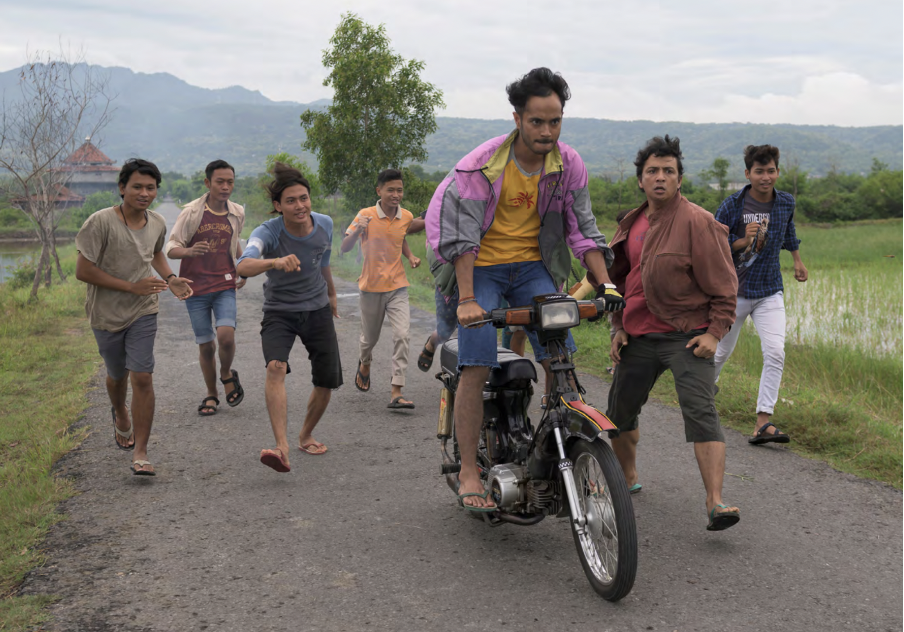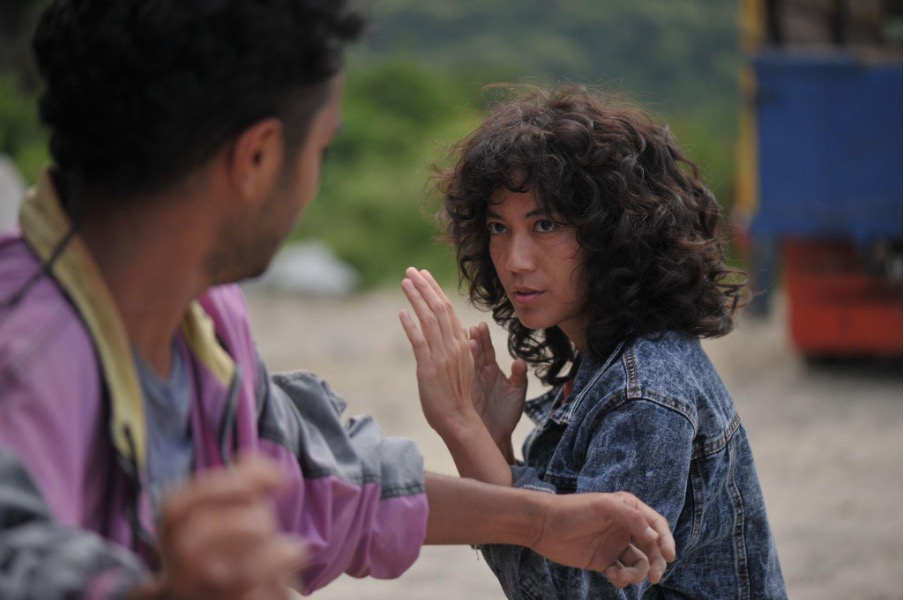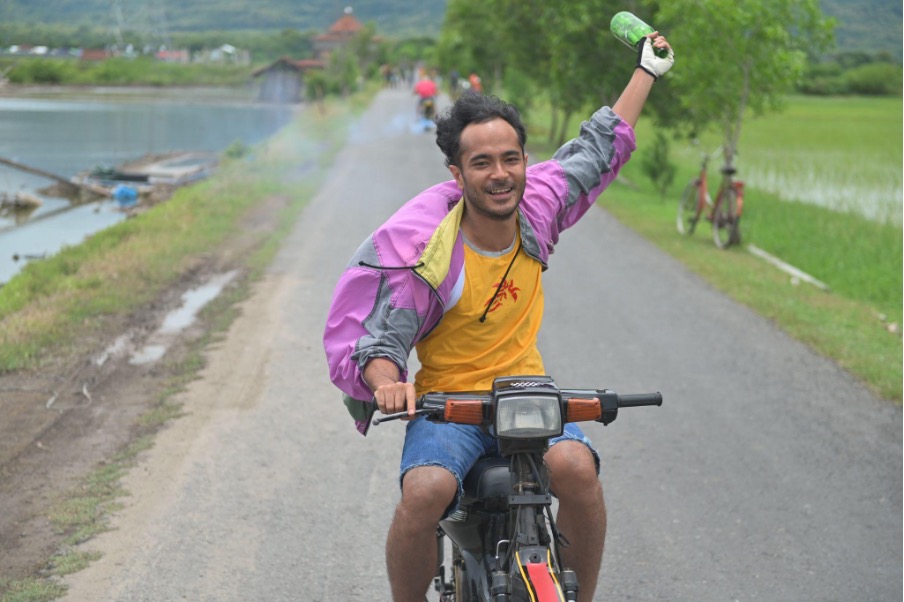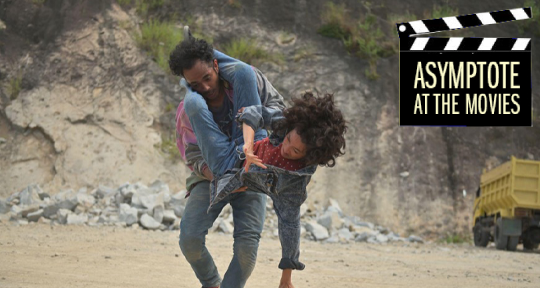Arguably one of the most recognised Indonesian writers in world literature, Eka Kurniawan has earned a global audience—most notably for being the first Indonesian to earn a spot on the Man Booker International longlist with translator Annie Tucker for the sweeping novel, Beauty is A Wound. This August, acclaimed Indonesian director Edwin bagged the Golden Leopard at the Locarno Film Festival for his adaptation of Eka’s Vengeance is Mine, All Others Pay Cash (reviewed here). The story follows the young Ajo Kawir, who tries to compensate for his sexual impotence by turning to fighting, subsequently falling in love with the bodyguard Iteung. In this special edition of Asymptote at the Movies, we are honoured to have Edwin discuss his adaptation of Eka’s work with assistant editor Fairuza Hanun and former-Editor-at-Large for Brazil Lara Norgaard in a wide-ranging conversation that considers the role of language in the multicultural archipelago, critiques of masculinity, and how Eka’s famed fragmentation on the page can hold up as it moves onto screen.
Note: the following piece includes discussion of sexual violence.
Fairuza Hanun (FH): Edwin, I’ve been fascinated by your works, especially Aruna & Lidahnya and Blind Pig Who Wants to Fly, which have explored numerous topical issues, ranging from—but not limited to—gender, race, sexuality, culture, and identity. However, compared to the gritty action-packed Vengeance Is Mine, All Others Pay Cash, your earlier films retained more “domestic” and bittersweet compositions with a main narrative thread. Eka Kurniawan’s literature is well-known for its meandering plots and fusion of socialist and magical realism, and although Vengeance is one of Kurniawan’s more straightforward works, it still possesses his love for multiple threads. This poses my first questions: what are your thoughts on the process of adapting Kurniawan’s braided narrative into a limited screen time? Were there any challenges in transposing his subtlety and explicitness when approaching the taboos of Indonesian society?
I know quite little about the technicalities of cinematography, but I found the film to be absolutely stunning, every scene evoking emotion—the simultaneous isolation and communalism in a village community—and remaining faithful to the descriptions in the book; the actors did a spectacular job at fleshing out the characters. I noticed that the book’s dry, witty humour remains present throughout the film, as well as some of the vocabulary from KheaKamus Besar Bahasa Indonesia (KBBI) being maintained in the dialogue. This intrigued me, as the effects of dialogue in literature and cinema often differ; for instance, how it is made more “acceptable”, or how it can be ignored, if dialect—i.e. contractions, local diction, etc.—is “smoothed out” in writing, reconstructed into a formal, almost mathematically-structured, rendition. Yet, in film, an accurate depiction of the setting can make such a move jarring something out of place in a village with perhaps limited resources to literature, as it seems the people are still steeped in traditional, often superstitious, interpretations. Language should be an intercultural exchange, and Indonesia is a multicultural, multilingual country; mediums of expression which strive to preserve culture should not promote or normalise the process of lingual centrism. I feel that the widespread use of Indonesian and its normalisation or expectations pose an issue of the slow erasure of local languages which have been cultivated throughout generations, to be replaced by the “central” national language.
In regards to that, what are your thoughts on language in the arts, and the process of adapting a book to a film and vice versa? And what is your opinion or definition of a faithful adaptation?

Lara Norgaard (LN): I want to riff on the idea of plot that Fairuza raises. One striking element of the book Vengeance is Mine, All Others Pay Cash, in my reading, is how Kurniawan builds plot through layered vignettes. This method of careful fragmentation fosters a specific relationship between plot and the passage of time. With the exception of notable flashbacks, the plot moves forward in time; there is a tug from past to present without a strictly linear structure connecting each individual scene in the novel. If I were to visualize the novel’s plot, I would not draw a line, but instead a scattered plot of points that, as a collective, come together in a temporal impulse. Shrapnel from an explosion of subjectivity and memory: multiple, dispersed, in motion, yet all part of the same series of events.
When I sat down to watch your adaptation, I was curious to see how you would translate this structure from the written word to film. I felt that, more than in dialogue or action, it was through the soundscape and visual motifs that the combination of fragmentation and continuity came through. Beyond the soundtrack (and what a soundtrack!), specific sounds repeatedly punctuate the transitions from one vignette to the next—a jarring telephone ring cuts between scenes in several instances, resulting in a sharp tonal break. But in the repetition of this transition comes a kind of rhythmic continuity. Other sonic motifs, such as the radio, are not as fundamental to transitions between scenes; instead, their pervasive presence across disparate vignettes builds a cohesive soundscape, a connective tissue across fragmented plot.
I found that visual motifs similarly created continuity in discontinuity. Quiet, uncanny shots of the moon—in contrast to the cacophony of the phone call—offer repeated visual transitions between vignettes. Other potent motifs—that of trucks, for example—are omnipresent in the film, as a sort of symbolic backdrop for the action at hand. The repetition of scenes with trucks appears almost as a collective unconscious expression of masculinity, which Ajo Kawir only wrestles with when he becomes a truck driver towards the film’s end.
With these reflections, I’d like to add to Fairuza’s broader question about your adaptation of Kurniawan’s multiple plot threads. What was your process building rupture and repetition when directing the film? How do rhythm, structure, and temporality of plot relate to the thematic questions of taboo and masculinity?
Edwin: Hi Fairuza and Lara, thank you for your detailed observation, passionate response and warm appreciation for Dendam. I must apologize, English is not my first language, and written words are not my best medium, either. But I will try my best to respond to your questions and keep the discussion going.
Regarding language, it was our choice to use a certain style of dialogue (Bahasa Indonesia baku) as a reference to the rigid style of dialogue in 80s and 90s action films (and most films of that era), which is distinctive to those of us who grew up watching these films. It is an homage that contains our criticism to exactly what Fairuza described: this era in the film is notorious for a forced, indoctrinated nationalism, evident in the language spoken.
Bahasa Indonesia was hailed as what “unites” us and was force fed to our very diverse society—for example, via popular culture and movies. It is a formal style of language which is actually very different from our casual day-to-day colloquial speech, which is often filled with ethnic words and dialects. And just like all the other forms of violence that we talk about in this film, this force-fed Bahasa Indonesia was so consistently used everywhere that it became normalized. For a long period of time, we accepted it as a reality of our popular culture—that films needed to sound that way, although this was not a reflection of our actual daily life.
On film adaptations and accommodating multiple plot threads in the limited screen time: Eka and I agreed that books and cinema are different forms of literature, and that I will be using a different language than his in telling this story. In our process, and our many discussions even before drafting, I wanted to know what is important for him and share with him what is important to me—characters, plot points, ambience, or other elements. We understood the limitations of production and screen time, and we knew that Dendam, the movie, will tell its own story.
Faithfulness in adaptation means different things to every filmmaker, and it is totally fair that some films aim to stay true to every element. However, for me, in this film, “faithfulness” does not require that everything in the book be included in the film. Faithfulness is embodied in the essence, spirit, and style—which was achieved through my drafting process with Eka. About the multiple plotlines—how Lara describes the book as containing “a scatter plot of points” like “shrapnel from an explosion”—these are words I have also used to describe my fragmented, non-linear storytelling in Babi Buta Yang Ingin Terbang (Blind Pig Who Wants to Fly). However, Dendam is somewhat more linear; as Lara said, “there is a tug from past to present without a strictly linear structure”, but the moments are “multiple, dispersed, in motion” in a “careful fragmentation”.
Lastly, about how the rhythm, structure, and temporality of plot relate to the thematic questions of taboo and masculinity, I think the soundscape itself is in itself a tribute to the style of 90s action films—or at least, our memory of it. The rupture and repetition that you mention is present in the scoring, where our music director has created a leitmotif per character, and they will be repeated and/or interrupted, when characters meet in a scene.

FH: Since we’re on the topic of masculinity, I would like to bring one of the key plot devices of social critique in Dendam, which is sexual impotence. Under the cultural influence of a patriarchal, biological-essentialist world, sexual impotence is classified as a sexual dysfunction—a “reduction” of manliness. This is experienced by our main character Ajo Kawir, and the cultural norm suggests that sexual potency is a fundamental issue for his expression of “manliness” and the pleasure of his marriage. To somewhat “make up” for his lack of culturally-prescribed masculinity, he nurtures a passion for fighting and brawling. After the wedding, however, Iteung dissuades him from pursuing the well-paid hitman career offered to him, and thus he is unable to afford a house for his new family. Considering the gender roles assigned to him, both inabilities disqualify him as an adult man.
Meanwhile, Budi’s sexually-charged relationship with Iteung draws a critical comparison of “real” masculinity—represented in normative sexual behaviour—and emasculation—sexual dysfunction. Budi is Ajo Kawir’s exact opposite; he demonstrates a capacity to run a highly successful, albeit prurient, business, and a capacity for sexual pleasure. Not only Budi, but Ajo Kawir’s sexual drive can often be contrasted with those of his peers and figures of authority throughout the film. In the predominant cultural influence of the West, this perspective of masculinity is extracted from generic studies of sexuality and masculinity, and I wonder how it would translate into the context of Indonesian culture. May we know what your perspective is on how Dendam criticises masculinity and sexuality in an Indonesian cultural context? And how do you think normative sexual behaviour and sexual dysfunction would be perceived if the subject were a woman instead of a man?
Edwin: Ajo Kawir and Budi are men who are affected by the label of “masculinity.” Indonesian culture—and in this context, I mean the culture of most people living in Java—as Fairuza noted, has been influenced by a simplified Western perspective: what it means to be masculine is reduced to biological issues, physical attributes, and other traits that are easily seen, measured, and described.
Masculinity has to be exhibited outwardly, so that it can be measured, compared, proven. These acts of exhibition are very visible in mainstream culture; I saw them all the time, as someone who grew up in Java. Size matters—literally in every field. Education is measured by grades. For example, grade 5 means you have failed to learn the moral ethics of Pancasila. Regardless of whether morality can be measured at all in the first place, those numbers were accepted and normalized as being the mainstream culture of everyone living there. Javanese culture also has its own set of measurements. Everything, including qualities as complex as gender or sexuality, has to fit into a system of measurability, which, like it or not, simplifies and makes generalizations out of diverse and complex human qualities.
Unfortunately, this culture of measurement combines with the religious rules and norms that also play out in social life. Islam, Christianity, and Catholicism—the religions most commonly practiced in Java—all have such rules, many of which impose authoritative evaluations on gender and sexuality. Javanese culture, together with values imbued through religion, perpetuate a patriarchal culture that dictate the norm and even the laws imposed in Indonesian society, not only in Java but across the country as a whole. This mix of rules and values based on Javanese culture and religion, intensified by the military dictatorship, end up forming the patriarchal culture that people adhere to in everyday life—and of course, that culture doesn’t allow space for the complexity of gender and sexuality. There isn’t space for questioning sexuality, for questioning the social roles women occupy. Even sensitive men are deemed unacceptable.
Ironically, even though Indonesia appears more democratic today than under the past dictatorship, it is still rife with that very same patriarchal culture embedded in everyday life. That’s why violence persists. It is easier to bark commands than to observe and listen. Men who cry are still considered a problem. The diversity of human feelings and shades of human characteristics have no place in that culture.

LN: Thank you, Edwin, for your thought-provoking response. I found your comments on the film’s intertextuality—its homage to 80s and 90s action films in the dialogue and soundscape—especially illuminating.
Fairuza, your comments on the paired motifs of sexual impotence/prowess reminded me of the dark underbelly that pairs with—and indeed motivates—the crises of masculinity so fundamental to the plot of the film. Sexual violence is omnipresent: witnessing rape is the root cause of Ajo Kawir’s persistent impotence; Iteung’s school teacher molests her as a child, a trauma that, in the film, Iteung recalls when she sleeps with Budi. Behind the “‘real’ masculinity of normative sexual behavior” are cycles of normalized gendered violence.
In this sense, the question of what would happen if a woman were the subject of this representation of sexual behavior is particularly interesting and complex. The sexual experiences of women are fundamental to the film but cast in proximity to violence and trauma. Certain moments of organic female desire might seem to complicate or act as a foil to this narrative; uncoerced, Iteung feels desire for Ajo Kawir, and that desire cannot be satisfied through normative sexual behavior because of her partner’s impotence—but the solution lies in Ajo Kawir’s hand becoming a kind of sexual prosthesis. In many ways, he remains the subject of the sexual dynamic, but with a stand-in appendage.
To add to Fairuza’s last question, I would like to hear what you think about the representations of sex when crafting a story that explores normative masculinity with men as primary subjects. Edwin, in your view as a director, what are the limits of depicting assault? Do you feel that there are risks to over-representing sexual violence, and how do those risks differ in a visual as opposed to written format? If so, how did you navigate those limits and risks? And how do you see women’s sexuality in the film—are there moments when the camera escapes the male gaze?
Edwin: I paid particular attention to two scenes so that they wouldn’t be misunderstood in my effort to portray sexual violence. First, the scene of Rona Merah’s rape, which Ajo Kawir and Tokek spy on when they are children. Secondly, Iteung’s traumatic memories of sexual assault at the hands of her teacher. There was no way to cut either scene from the narrative. The sexual violence that Rona Merah and Iteung experience are foundational traumas in Ajo Kawir’s and Iteung’s respective character development. We follow both characters before and after knowing the source of their trauma. My aim was to communicate that trauma to viewers. But communicating trauma isn’t a simple matter of making violence visible; we experience trauma through emotion, so I focused on trying to create those feelings. I invited viewers to feel, rather than watch, these events.
For the Rona Merah scene, I move the camera’s point of view away from Ajo Kawir, whose emotions shift slowly from curiosity to distress. I direct the viewer’s gaze not to what Ajo Kawir sees as a child, but instead to what the character feels. Rather than have the camera rest on the rape, I focus on what Ajo Kawir hears, the emotions he experiences. The same goes for the second scene. From the start, I knew I did not want to portray sexual assault visually; I felt it was more important to impart the feeling of trauma to the audience, rather than actually depicting the traumatic event itself. I wanted those watching the film to understand and experience what Iteung felt. This is my effort to ensure that the characters in the film are not merely objectified.
Fairuza Hanun is a writer, an assistant editor of Asymptote Journal, co-founder of IWEC Indonesia, and co-editor in chief of youth- and POC-led GENCONTROLZ Magazine. Currently, she is a student in Foundation of Art and Education at the University of Nottingham.
Lara Norgaard is an essayist and translator of Indonesian, Portuguese, and Spanish into English. Her work has appeared in publications including Asymptote Journal, Public Books, The Jakarta Post, and Cuíer (Two Lines Press), and she is a 2021 PEN/Heim Translation Grant recipient. Currently, she is a PhD student in comparative literature at Harvard University researching post-dictatorship literatures.
Edwin was born in Surabaya, East Java. His short Kara, the Daughter of a Tree became the first Indonesian film selected at Director’s Fortnight, Cannes Film Festival 2005. Edwin is also the only Indonesian director selected in Take 100: The Future Film of Film—100 New Directors (CINEMA) published by Phaidon, 2010 curated by ten world film festivals including Cannes, Berlin, Venice, Locarno, Toronto, Sundance, Busan, Hong Kong, Istanbul and Buenos Aires. In 2012, Edwin received the Edwin Yang New Talent Award at the Asian Film Awards, Hong Kong. In 2017, Edwin won the Citra Award for Best Director for Posesif, as well as Best Film at the Jogja-NETPAC Asian Film Festival (JAFF). His latest project, Vengeance Is Mine, All Others Pay Cash won Golden Leopard at Locarno Film Festival.
*****
Read more on the Asymptote blog:
- Strangely Familiar: A Menagerie of Contemporary Thai and Indonesian Writing
- The Queen’s Argot: The Language of Chess Around the World
- Writing Orang-orang Oetimu, Writing Wounds

